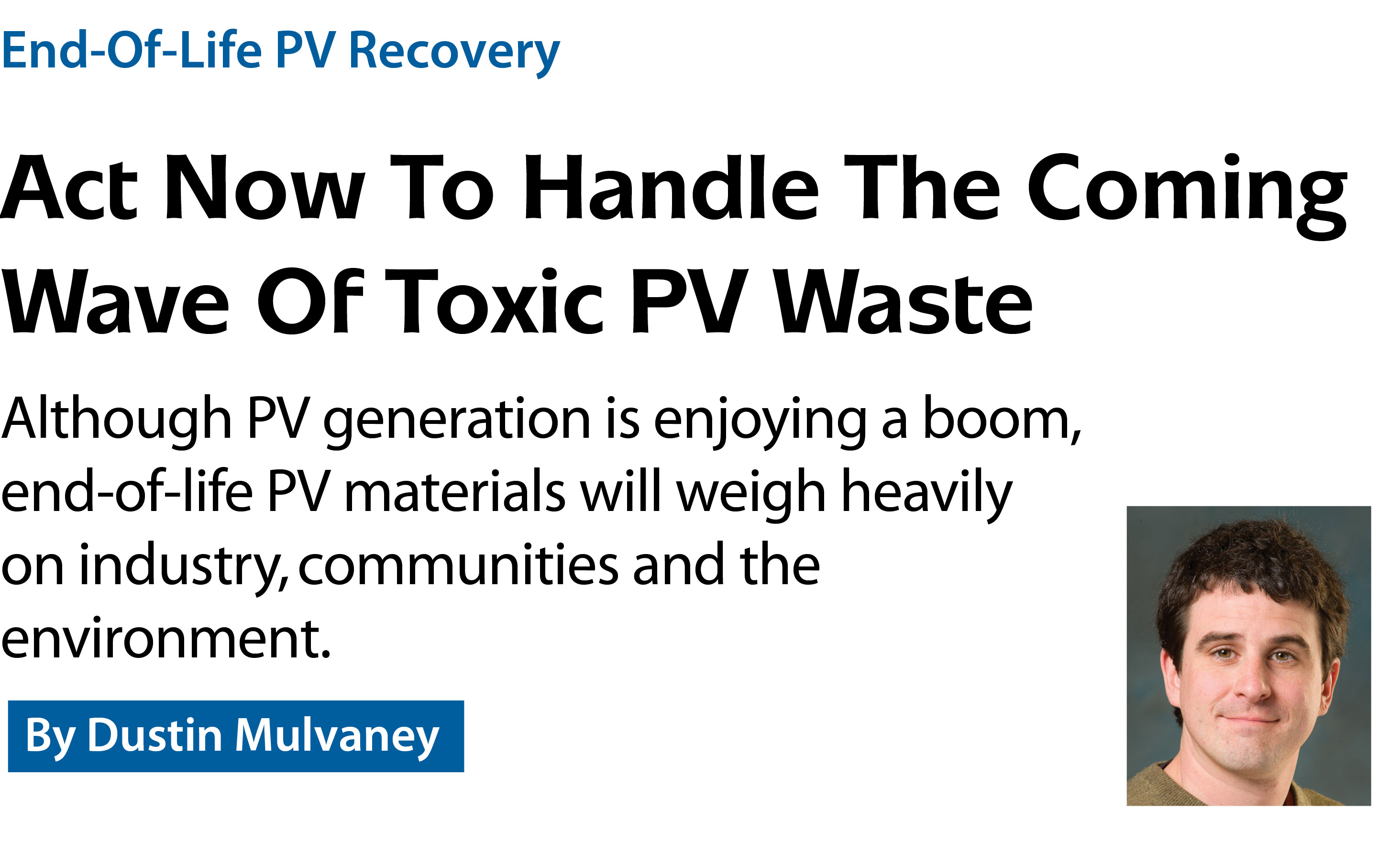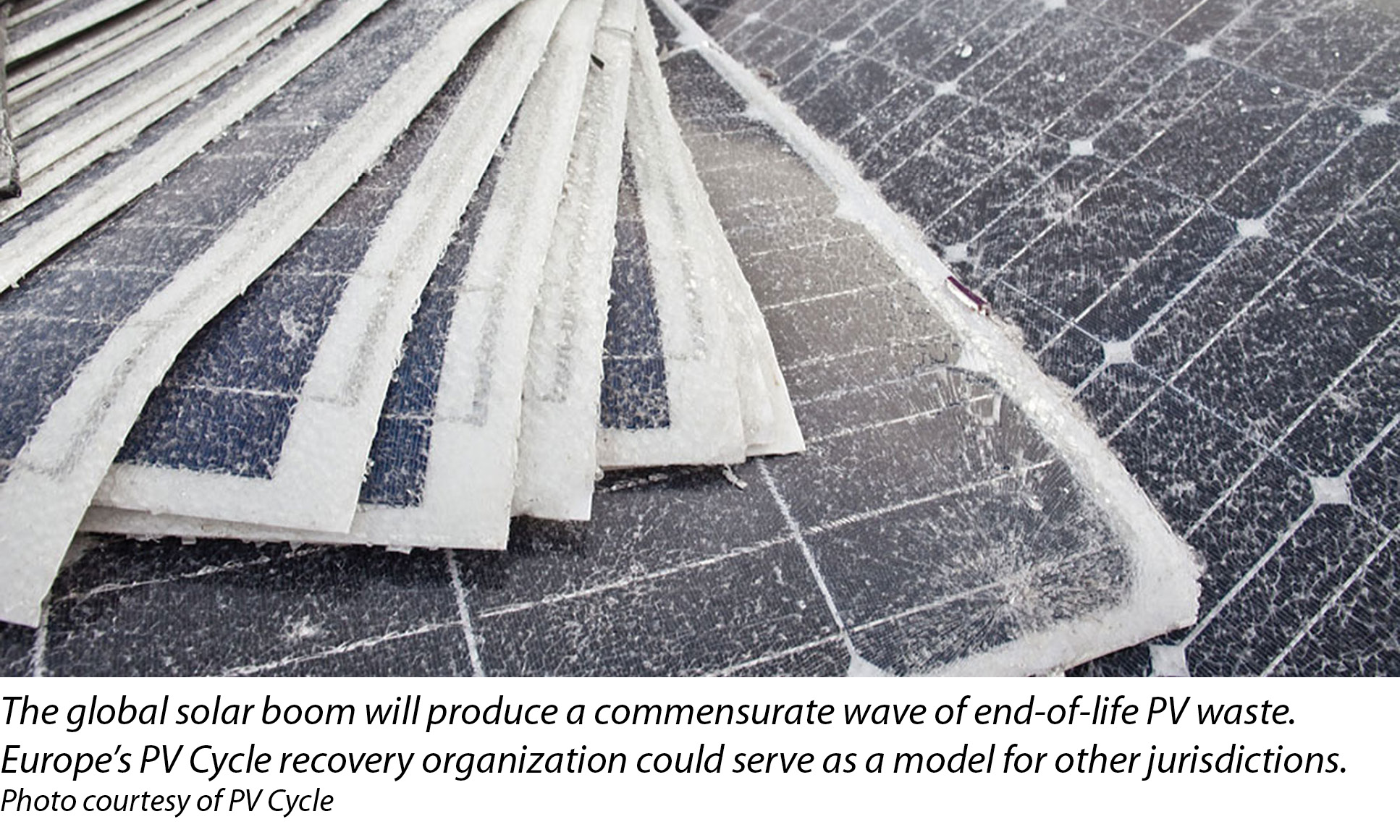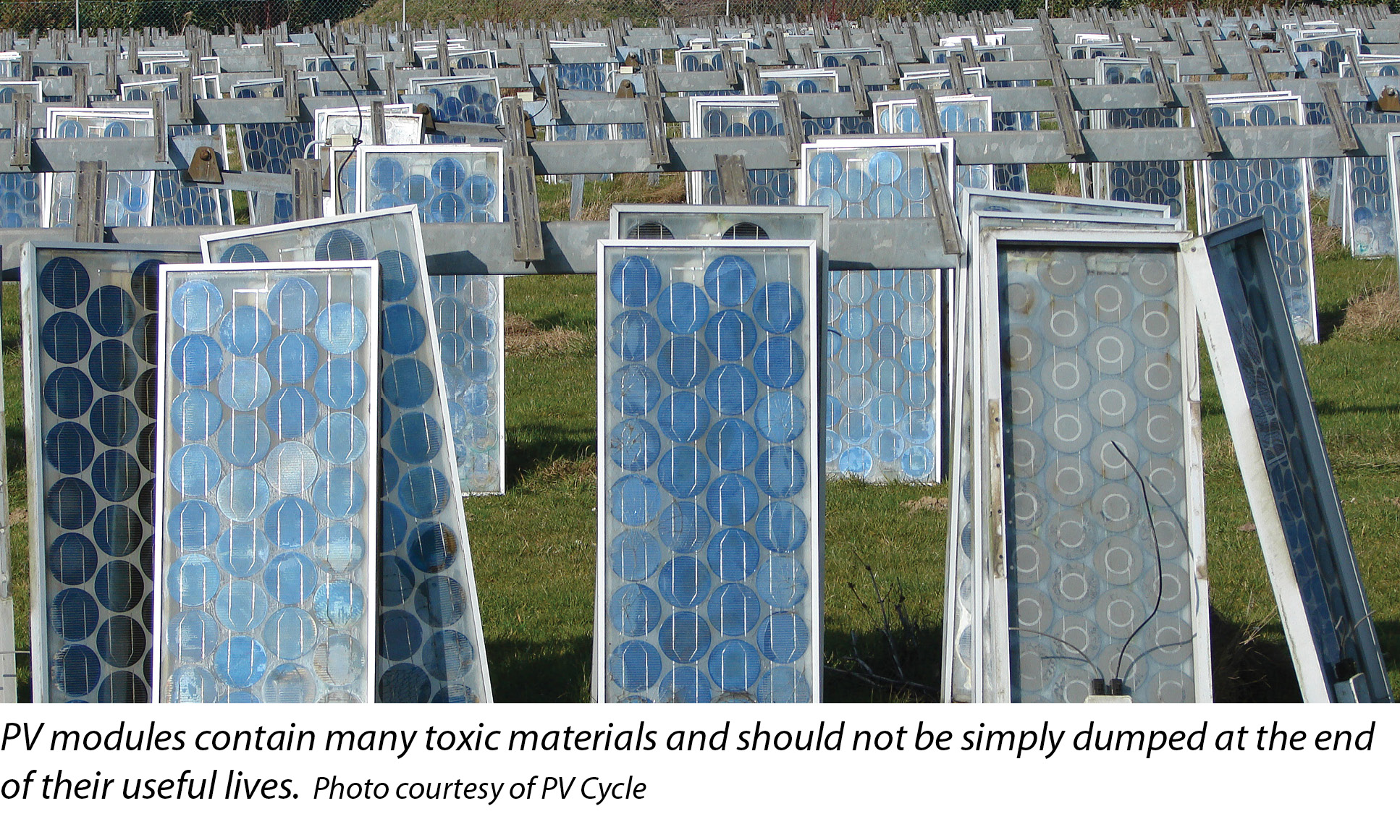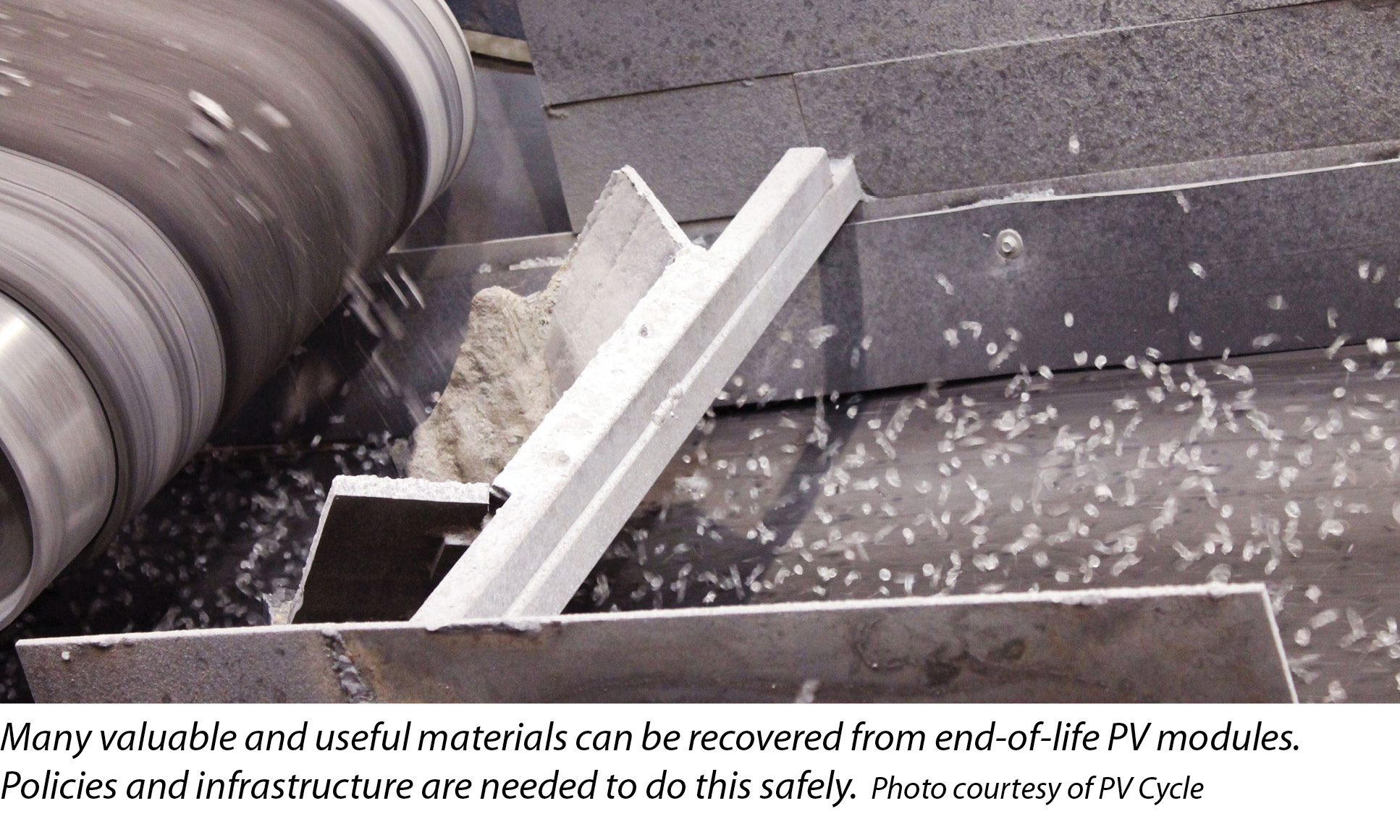

301 Moved Permanently
The photovoltaic industry is undergoing remarkable growth. Globally, the industry reached nearly 40 GW of annual production in 2013, continuing a trend of 20% and greater annual growth rates. Cumulative global installations of PV modules at the end of 2013 totaled over 140 GW. Every gigawatt of PV capacity represents somewhere between eight million to 10 million PV modules - meaning that, today, there are already billions of PV modules installed worldwide.
The U.S. has installed about 12 GW of distributed and utility-scale PV. By 2050, the U.S. Department of Energy projects that the nation will have cumulatively installed 700 GW of PV modules. The Energy Information Administration estimates that residential rooftop PV will continue to grow at a rate of 6.8%. This amounts to hundreds of billions of PV modules.
There are tremendous benefits coming online with these PV systems. Electricity from PV displaces the dirtiest energy sources: the fossil-fueled peaker plants that provide electricity during peak hours of the day, particularly on sunny, hot days. This means cleaner air and fewer emissions that cause photochemical smog and release particulate into the air we breathe in our communities. There are also unquestionable benefits to our climate. The greenhouse-gas (GHG) emissions related to manufacturing PV modules are negligible compared to the lifetime GHG savings after installation.
End-of-life PV waste
Despite these numerous environmental and climate benefits, PV generation has some environmental and social challenges that require proper management and planning. One important challenge is related to disposal at the end of the product’s useful life. PV modules degrade in power output over time until they are no longer capable of generating sufficient electricity or are no longer meeting the needs of the customer, homeowner and power plant operator alike. Companies work diligently in research and development to ensure this degradation is minimized, and many PV modules can, in fact, operate for many decades without an appreciable output decline. However, the reality is that every PV module will meet its end of life someday and become PV waste.
Where do these end-of-life PV wastes go? Nearly all companies offer generous warranties on PV modules that guarantee a certain power output - commonly 80% - after 20 to 25 years. So most of the solar panels on rooftops and in power plants are not going to be decommissioned anytime soon. Somewhere between 0.1% and 1% of all PV modules are defective or broken before they reach their end user. Some of these end-of-life PV modules are discarded from manufacturing facilities. These end-of-life modules might be broken on-site or might fail quality control, possibly even for cosmetic reasons. A similar stream of end-of-life PV is from modules that are removed early because they are defective or do not meet warranty claims.

End-of-life PV module waste from homeowners and power plants will represent the largest volume of end-of-life PV because 98% to 99% of those that are made are also installed. The problem is that this looming tidal wave of end-of-life PV modules remains invisible because these large volumes will not show up for 20 to 40 years. When this tide of waste does arrive, it will show up in very high volumes. The industry’s outstanding growth rate assures this will be the case. Where will these end-of-life PV module waste flows be directed? Informal recycling networks in developing countries? Local landfills? Smelters? High-value recycling? Much of this remains undetermined.
To estimate how much PV module waste will be generated and when we can expect these end-of-life management problems to arise, researchers at Brookhaven National Labs have provided the following framework:
- How much PV was produced by the industry and when?;
- How much does each PV module weigh per rated power output?;
- How much waste is generated in production at PV manufacturing plants?;
- What percentage of PV modules are damaged or defective en route to or during operation? How many fail early?; and
- How long will the PV modules operate?
This framework finds that the industry will generate about 60,000 tons of PV waste in 2015. By 2050, over 20 million tons of PV waste will be generated annually. Although these PV waste volumes give a sense of the looming waste challenges, there are a number of reasons why PV module recycling is important, if not imperative, for the long-term success and effectiveness of PV deployment.

Waste not, want not
PV modules contain a number of valuable or rare materials, and proper recycling will ensure that these rare materials are recovered for reuse. Crystalline PV modules contain many valuable materials, such as copper, aluminum, silver and glass, that can be reused. These materials can be recycled into high-value glass or down-cycled into lower-value secondary glass products. Recycled silicon wafers also have value because there is a significant energy investment required to purify them. By recovering the silicon from PV cells, energy inputs can be reduced, less polysilicon would be refined and less quartz would be mined.
Tellurium, indium, gallium and molybdenum, which are some of the rarest elements in the Earth’s crust, are among the rare metals used in thin-film PV technologies. The presence of these valuable materials suggests that recycling would be both economically and environmentally beneficial in the long term. In fact, many studies show that the limited availability of some of these key resources means that PV demand cannot be met in the long term without recovering materials.
Tellurium, for example, is about 1,000 times more rare than the rare Earth elements that are the subject of ongoing trade disputes between the U.S., China, Malaysia and Japan. Indium is a key input to many thin-film PV technologies as a transparent conductive layer and is relatively rare. Competition for indium use in flat-screen displays could ultimately restrict its commercial production. The need to recover indium should, therefore, facilitate the recycling of copper indium gallium selenide (CIGS) modules. The recycling of amorphous silicon is one of the cleaner recycling processes of all PV technologies, although indium tin oxide is linked to occupational lung problems in flat-panel television recycling facilities. Some advanced PV technologies currently explored in scientific laboratories, such as dye-sensitized PV cells, require ruthenium, a platinum-group metal for which there is only about 12 tons mined annually. Molybdenum is used as a contact layer in some kinds of thin-film PV.
Thin-film PV modules can also be recycled. PV modules are first disassembled to recover valuable materials, such as copper wiring and aluminum if they have frames. Then, modules are shredded into small pieces. A process developed by Brookhaven National Labs and First Solar uses dilute acids to remove the metal compounds from the module. First Solar has developed a recycling operation at several of its manufacturing sites. Up to 95% of the tellurium can be recovered in the recycling processes for reuse. Though even with recycling, cadmium-telluride (CdTe) modules must be recycled safely and responsibly - hence, ambient cadmium emissions should be monitored to ensure that occupational exposures are minimized.
Approximately 90% of most PV modules are made up of glass. However, this glass often cannot be recycled as float glass due to impurities. Common problematic impurities in glass include plastics, lead, cadmium and antimony. Where present, these materials can only be down-cycled.
PV module toxicity
One concern raised with end-of-life PV is that spent modules may enter into the global electronic waste (e-waste) trade in end-of-life electronics. PV modules represent an e-waste recipe of toxic and valuable materials, where the former can be overlooked in pursuit of the latter.
Because crystalline silicon is the most widespread PV technology, lead is the most widespread toxic material in PV. The amounts of lead in crystalline PV vary from zero to several hundred grams per module, and it is typically found in solder and metallization pastes. According to the Silicon Valley Toxics Coalition’s annual survey of PV manufacturers, several PV manufacturers are able to produce PV modules without lead.
Cadmium is found in some kinds of thin-film PV, including CdTe and CIGS. Some have argued that CdTe has different physical properties than elemental cadmium and could be less toxic. For example, CdTe melts at a much higher temperature (1,041°F) than cadmium (321°F) and is less soluble in water. But there is little data to support claims about CdTe toxicity, despite the calls for better understanding of the environmental, health and safety of CdTe PV modules long before they were widely commercially available. Other research suggests that CdTe PV is the most toxic of commercially available thin-film technologies because of cadmium’s links to severe pulmonary inflammation and fibrosis. Cadmium and tellurium are considered more toxic than indium or gallium, and indium is more toxic than gallium. CIGS fabrication processes can use several regulated metals, including cadmium and selenium, creating the potential that end-of-life CIGS modules could be considered hazardous waste.
Almost all PV modules contain plastics for junction boxes that connect the solar cell to the wiring needed to deliver electricity. Although most of the thermoplastic materials used for junction boxes are so-called “halogen free” - meaning they contain no bromine or chlorine - some PV module junction boxes may contain brominated flame-retardants. Although it is critical that PV modules use the most fire-resistant materials possible for electrical equipment and wiring, there are many other materials available that do not contain the carcinogenic bromine-based materials.

Final destination, first responsibility
The global e-waste trade includes advanced automated facilities, but it also includes facilities with lax labor laws and occupational standards. There is also a separate informal processing sector that uses especially crude tools and equipment. Strongly formulated and enforced environmental health and worker protection standards for recycling can help minimize the toxic exposure and human rights abuses that currently plague the global e-waste trade.
The more likely destinations for end-of-life PV are landfills, waste transfer stations or recycling facilities. Discarding hazardous PV modules in landfills can pose risks because the lead and cadmium could leach into groundwater. One study found that the amount of cadmium leaching out would be less than the drinking water standard in Germany. Yet, a report from the Norwegian Geotechnical Institute argued that the leaching of cadmium into the environment could occur even in slightly acidic water.
The costs imposed on these facilities are a burden to local government. Cost estimates for PV module disposal depend on the waste classification and distance traveled to recycling and disposal facilities. These estimates range from $0.05/W to $0.50/W. Depending on the hazardous waste determination, this translates into $5 to $100 per module - likely toward the lower end.
The key to effective long-term management of solar waste is the establishment of domestic recycling infrastructure based on extended producer responsibility (EPR), a policy framework that ensures manufacturer responsibility for the lifecycle effects of their products. One approach to avoiding the problem of PV waste entering the environment is to employ a lifecycle management strategy based on EPR.
Strong EPR policies can even create incentives for product designs that are safer, easier and cheaper to recycle. The European Union’s Waste Electronics and Electrical Equipment Directive has produced the PV Cycle organization take-back and collection scheme.
To ensure safe and responsible recycling of modules sold in the U.S., we need to develop domestic recycling networks and infrastructure. However, more collaboration and collective action is needed across the PV industry to encourage strong recycling policies, best practices and to encourage design with the environment and recycling in mind.
In 2012, the Silicon Valley Toxics Coalition collaborated with the Basel Action Network to develop language that would include PV in the widely used e-Stewards certification process. The effort brought together PV industry experts, electronics recycling industry representatives, scientists and policymakers to develop a list of best practices for handling end-of-life PV.
The welcomed rapid growth of PV installations means there is a limited window of opportunity to establish recycling policies and practices to manage end-of-life PV waste. If waste issues are not preemptively addressed, the industry risks repeating the disastrous environmental mistakes of the electronics industry. The toxic e-waste made up of discarded computers and other electronics is shipped to developing nations, such as India, China and Ghana, for manual disassembly, which exposes workers and communities to highly hazardous chemicals. The dumping of recycling waste also causes serious environmental damage.
Distant time horizons suggest that mandatory EPR will be required to encourage participation, eliminate free riders and avoid economic penalties for good product stewards. There are numerous companies exploring or experimenting with recycling (e.g., First Solar and SolarWorld), but this adds additional costs, and at a time when the industry is surviving on razor-thin margins, it is not fair to these industry leaders to bear costs that others do not.
There are multiple benefits of establishing a mandatory, industry-wide EPR program for recycling end-of-life PV. The long-term success of the industry would benefit from an additional supply of critical metals. EPR would safeguard against the emergence of PV waste problems in local landfills or global e-waste flows. PV recycling would lower the energy payback times and accelerate the GHG savings from using lower-energy-intensity inputs. An EPR program would also encourage PV module reuse by establishing local sites for collection, as many end-of-life PV modules could be repurposed.
The establishment of an EPR program would make PV manufacturers think harder about designing for the environment - meaning developing PV modules without hazardous inputs and with recycled rare metals. This would result in clean energy that is cleaner than ever. S
End-Of-Life PV Recovery
Act Now To Handle The Coming Wave Of Toxic PV Waste
By Dustin Mulvaney
Although PV generation is enjoying a boom, end-of-life PV materials will weigh heavily on industry, communities and the environment.
si body si body i si body bi si body b
si depbio
- si bullets
si sh
si subhead
pullquote
si first graph
si sh no rule
si last graph